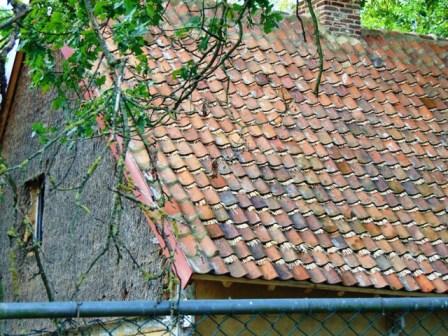The simplest form, Spanish style, consists of a half cylinder, tapered on one side. With the narrow side down the higher-level pans cannot slide down. Adjacent the joint between two rows with the convex side down is covered by a row with the convex side up.
The model is called monk and nun, without closure. The nuns are thus covered by the monks. (Have you always secretly thought.) This gives a double cover. (Also still!)
How nuns and priests multiply? By cell division! (Theo Bergsma)
 Later came noses under the under tile so it could be hung at a bar. The upper tile got a hat on top to support the higher laying tile.
Later came noses under the under tile so it could be hung at a bar. The upper tile got a hat on top to support the higher laying tile.
Actually, all tiles are variants of this. The hollow tile or Pottelberg tile is a monk and nun to each other: so you get a slight s shape, laying flat. To get these tiles stable and get a better wind seal were straw puppets used ,inserted between the tile and the batten. A bundle of straw (just over thump thick) was double fold and about 4 cm below the head bound with straw. The loose bottom end laid about 4 cm on the underlying tile. The protruding straw rots on the outside a few centimeters away. The puppets closed the gaps pretty well.
 In the newer versions, the hollow part becomes more straight and larger. By grooves and ridges both on the side and on the front side, single and even double closures can be made . This improves the water - and windproof significantly. There are also models created that are not placed directly under each other, but laid in stretcher bond. For the finishing of the sides special (left and right) shapes are made with a 90⁰ downwards bent part.
In the newer versions, the hollow part becomes more straight and larger. By grooves and ridges both on the side and on the front side, single and even double closures can be made . This improves the water - and windproof significantly. There are also models created that are not placed directly under each other, but laid in stretcher bond. For the finishing of the sides special (left and right) shapes are made with a 90⁰ downwards bent part.
Making tiles
If you can make pottery, you can also make a half pot without bottom. Raw materials and firing are similar.
A plain roof tile is after 14 to 20 hours of drying, and after 15 to 16 hours of firing at a temperature of 1,020 degrees nature red.
If the furnace is fired high, and additional oxygen supply is closed, oxygen is converted from the metal compounds in the clay and the tile becomes gray blue. This is called throttling.
After drying also a clay or glaze layer may be applied with metal oxide.
Because you need a lot of roofing tiles it’s handy to use a form and a (hand) press. It is much easier and faster, and provides a more uniform result.
As you press in the still moist clay a hole in the tab that the tile catches on the batten, then they can be nailing or bond, and also used as cladding.
A roofer falls. A passerby asks ”What happened?” Roofer:’ I don’t know. I just got here.”
